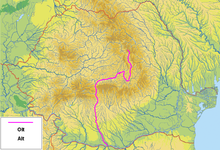Olt (river)
River in Romania From Wikipedia, the free encyclopedia
River in Romania From Wikipedia, the free encyclopedia
The Olt (Romanian and Hungarian; German: Alt; Latin: Aluta or Alutus, Turkish: Oltu, Ancient Greek: Ἄλυτος Alytos) is a river in Romania.[1][2] It is 615 km (382 mi) long, and its basin area is 24,050 km2 (9,290 sq mi).[2][3] It is the longest river flowing exclusively through Romania. Its average discharge at the mouth is 174 m3/s (6,100 cu ft/s).[3] It originates in the Hășmaș Mountains of the eastern Carpathian Mountains, near Bălan, rising close to the headwaters of the river Mureș. The Olt flows through the Romanian counties of Harghita, Covasna, Brașov, Sibiu, Vâlcea, and Olt. The river was known as Alutus or Aluta in Roman antiquity. Olt County and the historical province of Oltenia are named after the river.
| Olt | |
|---|---|
 The Avrig reservoir on the Olt | |
 | |
| Location | |
| Country | Romania |
| Counties | |
| Cities | |
| Physical characteristics | |
| Source | Hășmaș Mountains |
| • location | Bălan, Harghita |
| • elevation | 1,440 m (4,720 ft) |
| Mouth | Danube |
• location | near Turnu Măgurele |
• coordinates | 43°42′46″N 24°48′1″E |
| Length | 615 km (382 mi) |
| Basin size | 24,050 km2 (9,290 sq mi) |
| Discharge | |
| • location | mouth |
| • average | 174 m3/s (6,100 cu ft/s) |
| Basin features | |
| Progression | Danube→ Black Sea |
| Tributaries | |
| • left | Râul Negru, Bârsa, Topolog |
| • right | Cormoș, Cibin, Lotru, Olteț |
| River code | VIII.1 |
 | |
Sfântu Gheorghe, Râmnicu Vâlcea and Slatina are the main cities on the river Olt. The Olt flows into the Danube river near Turnu Măgurele.

The main cities along the river Olt are Miercurea Ciuc, Sfântu Gheorghe, Făgăraș, Râmnicu Vâlcea and Slatina.
The Olt passes through the following communes, from source to mouth: Bălan, Sândominic, Tomești, Cârța, Dănești, Mădăraș, Racu, Siculeni, Ciceu, Miercurea Ciuc, Sâncrăieni, Sântimbru, Sânsimion, Tușnad, Băile Tușnad, Bixad, Micfalău, Malnaș, Bodoc, Ghidfalău, Sfântu Gheorghe, Ilieni, Prejmer, Hărman, Vâlcele, Bod, Feldioara, Hăghig, Măieruș, Belin, Apața, Aita Mare, Ormeniș, Baraolt, Augustin, Racoș, Hoghiz, Ungra, Comăna, Părău, Șercaia, Mândra, Făgăraș, Beclean, Voila, Viștea, Ucea, Arpașu de Jos, Cârța, Porumbacu de Jos, Avrig, Racovița, Tălmaciu, Turnu Roșu, Boița, Câineni, Racovița, Brezoi, Călimănești, Dăești, Bujoreni, Râmnicu Vâlcea, Budești, Mihăești, Galicea, Băbeni, Ionești, Olanu, Drăgoești, Orlești, Dobroteasa, Prundeni, Vulturești, Verguleasa, Drăgășani, Voicești, Teslui, Grădinari, Strejești, Curtișoara, Pleșoiu, Găneasa, Olt, Slatina, Slătioara, Milcov, Piatra-Olt, Brâncoveni, Ipotești, Osica de Sus, Coteana, Fălcoiu, Mărunței, Drăgănești-Olt, Fărcașele, Stoenești, Dăneasa, Gostavățu, Sprâncenata, Băbiciu, Scărișoara, Rusănești, Cilieni, Tia Mare, Izbiceni, Lunca, Giuvărăști and Islaz.
The following rivers are tributaries of the river Olt (from source to mouth):[2]
For supply of drinking water and water for irrigation and for the production of hydroelectricity, 44 reservoirs have been built in the Olt river basin. There are 24 reservoirs for hydropower on the river Olt itself, and three on its tributary Lotru.[4] There are hydropower plants at (from source to mouth) Voila, Viștea, Arpaș, Scoreiu, Avrig, Gura Lotrului, Turnu, Călimănești, Dăești, Râmnicu Vâlcea, Râureni, Govora, Băbeni, Ionești, Zăvideni, Drăgășani, Strejești, Arcești, Slatina, Ipotești, Drăgănești, Frunzaru, Rusănești and Izbiceni. The total energy production of the 43 hydropower plants in the Olt basin was 2,980 GWh in 1996.[5]

Seamless Wikipedia browsing. On steroids.
Every time you click a link to Wikipedia, Wiktionary or Wikiquote in your browser's search results, it will show the modern Wikiwand interface.
Wikiwand extension is a five stars, simple, with minimum permission required to keep your browsing private, safe and transparent.